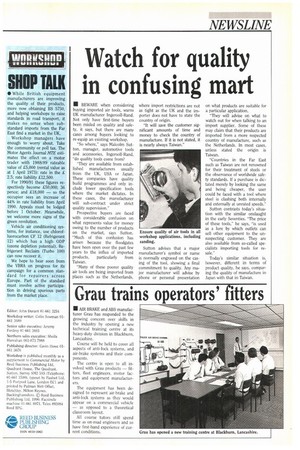Watch for quality in confusing mart
Page 95

If you've noticed an error in this article please click here to report it so we can fix it.
• BEWARE when considering buying imported air tools, warns UK manufacturer Ingersoll-Rand. Not only have first-time buyers been misled on quality and safety, it says, but there are many cases among buyers looking to re-equip an existing workshop.
"So where," says Malcolm Sutton, manager, automotive tools and accessories, Ingersoll-Rand, "do quality tools come from?
"They are available from established manufacturers usually from the UK, USA or Japan. These companies have quality build programmes and only include lower specification tools where the market dictates. In these cases, the manufacturer will sub-contract under strict quality supervision."
Prospective buyers are faced with considerable confusion on what represents value for money owing to the number of products on the market, says Sutton. "Much of this confusion has arisen because the floodgates have been open over the past few years to the influx of imported products, particularly from Taiwan.
"Many of these poorer quality air tools are being imported from places such as the Netherlands,
where import restrictions are not as tight as the UK and the importer does not have to state the country of origin.
"It will save the customer significant amounts of time and money to check the country of manufacture. If it is not stated, it is nearly always Taiwan."
Sutton advises that a major manufacturer's symbol or name is normally engraved on the casing of the tool, showing a final commitment to quality. Any major manufacturer will advise by phone or personal presentation
on what products are suitable for a particular application.
"They will advise on what to watch out for when talking to an import supplier. Some of these may claim that their products are imported from a more respected country of manufacture, such as the Netherlands. In most cases, unless stated the origin is Taiwan.
"Countries in the Far East such as Taiwan are not renowned for their treatment of steels or the observance of worldwide safety standards. If a purchase is dictated merely by looking the same and being cheaper, the user could be faced with a tool where steel is clashing both internally and externally at unrated speeds."
Sutton contrasts today's situation with the similar onslaught in the early Seventies. "The price of these tools," he says, "is used as a lure by which outlets can sell other equipment to the unsuspecting customer. They are also available from so-called specialists importing tools for resale."
Today's similar situation is, however, different in terms of product quality, he says, comparing the quality of manufacture in Japan with that in Taiwan.
































































































































